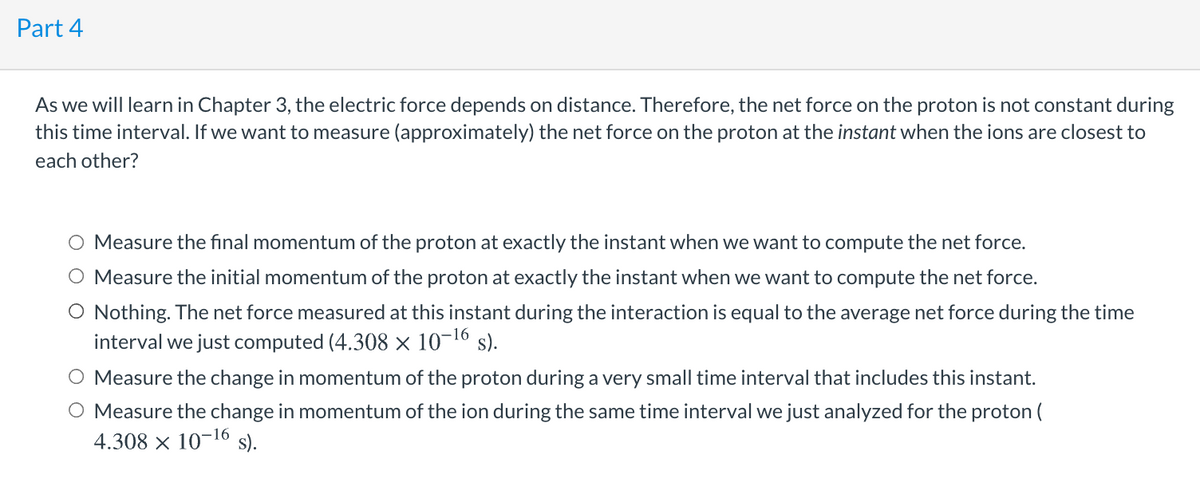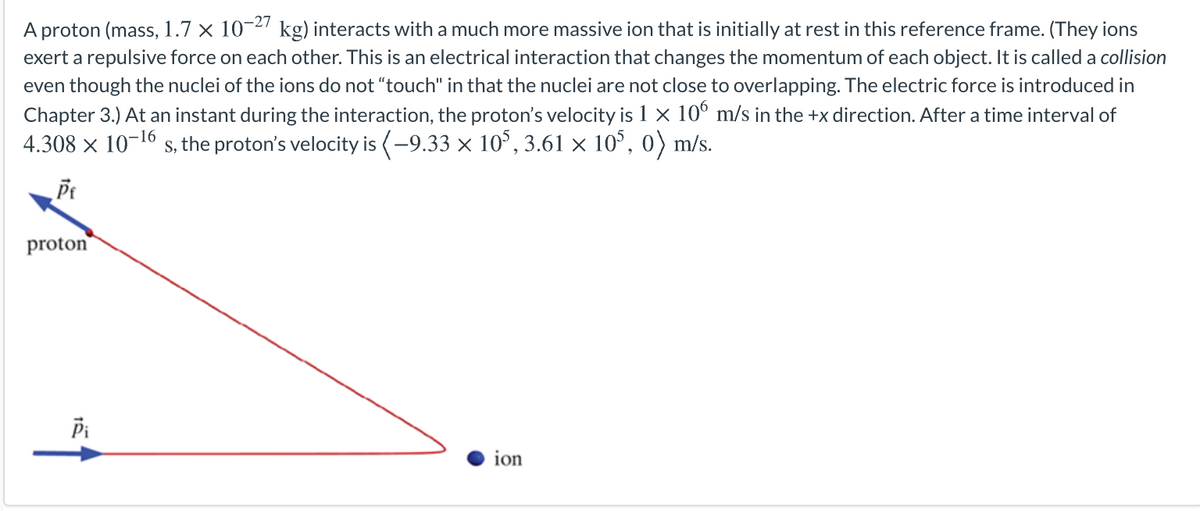A proton (mass, 1.7 × 10-2' kg) interacts with a much more massive ion that is initially at rest in this reference frame. (They ions exert a repulsive force on each other. This is an electrical interaction that changes the momentum of each object. It is called a collision even though the nuclei of the ions do not "touch" in that the nuclei are not close to overlapping. The electric force is introduced in Chapter 3.) At an instant during the interaction, the proton's velocity is 1 x 10° m/s in the +x direction. After a time interval of 4.308 x 10-16 s, the proton's velocity is (-9.33 × 10°, 3.61 × 10°, 0) m/s. proton Pi ion
A proton (mass, 1.7 × 10-2' kg) interacts with a much more massive ion that is initially at rest in this reference frame. (They ions exert a repulsive force on each other. This is an electrical interaction that changes the momentum of each object. It is called a collision even though the nuclei of the ions do not "touch" in that the nuclei are not close to overlapping. The electric force is introduced in Chapter 3.) At an instant during the interaction, the proton's velocity is 1 x 10° m/s in the +x direction. After a time interval of 4.308 x 10-16 s, the proton's velocity is (-9.33 × 10°, 3.61 × 10°, 0) m/s. proton Pi ion
University Physics Volume 1
18th Edition
ISBN:9781938168277
Author:William Moebs, Samuel J. Ling, Jeff Sanny
Publisher:William Moebs, Samuel J. Ling, Jeff Sanny
Chapter9: Linear Momentum And Collisions
Section: Chapter Questions
Problem 96AP: Two carts on a straight track collide head on. The first cart was moving at 3.6 m/s in the positive...
Related questions
Question
What was the impulse on the proton?
F→netΔt=
What was the (average) net force on the proton during this time interval?

Transcribed Image Text:Part 4
As we will learn in Chapter 3, the electric force depends on distance. Therefore, the net force on the proton is not constant during
this time interval. If we want to measure (approximately) the net force on the proton at the instant when the ions are closest to
each other?
Measure the fınal momentum of the proton at exactly the instant when we want to compute the net force.
O Measure the initial momentum of the proton at exactly the instant when we want to compute the net force.
O Nothing. The net force measured at this instant during the interaction is equal to the average net force during the time
interval we just computed (4.308 × 10-16 s).
O Measure the change in momentum of the proton during a very small time interval that includes this instant.
O Measure the change in momentum of the ion during the same time interval we just analyzed for the proton (
4.308 x 10-16 s).

Transcribed Image Text:-27
A proton (mass, 1.7 × 10¬2' kg) interacts with a much more massive ion that is initially at rest in this reference frame. (They ions
exert a repulsive force on each other. This is an electrical interaction that changes the momentum of each object. It is called a collision
even though the nuclei of the ions do not "touch" in that the nuclei are not close to overlapping. The electric force is introduced in
Chapter 3.) At an instant during the interaction, the proton's velocity is 1 × 10° m/s in the +x direction. After a time interval of
4.308 × 10-16 s, the proton's velocity is (-9.33 × 10°, 3.61 × 10°, 0) m/s.
proton
ion
Expert Solution
This question has been solved!
Explore an expertly crafted, step-by-step solution for a thorough understanding of key concepts.
This is a popular solution!
Trending now
This is a popular solution!
Step by step
Solved in 3 steps

Recommended textbooks for you

University Physics Volume 1
Physics
ISBN:
9781938168277
Author:
William Moebs, Samuel J. Ling, Jeff Sanny
Publisher:
OpenStax - Rice University

Principles of Physics: A Calculus-Based Text
Physics
ISBN:
9781133104261
Author:
Raymond A. Serway, John W. Jewett
Publisher:
Cengage Learning

College Physics
Physics
ISBN:
9781305952300
Author:
Raymond A. Serway, Chris Vuille
Publisher:
Cengage Learning

University Physics Volume 1
Physics
ISBN:
9781938168277
Author:
William Moebs, Samuel J. Ling, Jeff Sanny
Publisher:
OpenStax - Rice University

Principles of Physics: A Calculus-Based Text
Physics
ISBN:
9781133104261
Author:
Raymond A. Serway, John W. Jewett
Publisher:
Cengage Learning

College Physics
Physics
ISBN:
9781305952300
Author:
Raymond A. Serway, Chris Vuille
Publisher:
Cengage Learning

College Physics
Physics
ISBN:
9781938168000
Author:
Paul Peter Urone, Roger Hinrichs
Publisher:
OpenStax College

Physics for Scientists and Engineers, Technology …
Physics
ISBN:
9781305116399
Author:
Raymond A. Serway, John W. Jewett
Publisher:
Cengage Learning

Glencoe Physics: Principles and Problems, Student…
Physics
ISBN:
9780078807213
Author:
Paul W. Zitzewitz
Publisher:
Glencoe/McGraw-Hill